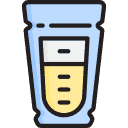You have likely heard horror stories about foremilk and hindmilk. The internet is full of warnings that create unnecessary anxiety for breastfeeding moms, leading some to believe they aren’t meeting their baby’s needs.
Here is the good news: foremilk and hindmilk imbalance (medically known as lactose overload) is rare. It is also highly treatable.
If you are stressed about milk composition, we are here to set your mind at ease. We will break down exactly how breast milk works, identifying the symptoms of an actual imbalance and showing you how to fix it.
Key Takeaways
- Understanding the difference: Foremilk is the hydrating, lactose-rich milk released first; hindmilk is the fatty, calorie-dense milk that follows.
- It is rare: True “imbalance” (lactose overload) is uncommon and usually stems from a massive oversupply or switching breasts too soon.
- Watch the diaper: Key symptoms include explosive, frothy green poop, excessive gas, and slow weight gain.
- Simple solutions: You can often resolve this by using laid-back breastfeeding positions and nursing fully on one side before switching.
Foremilk vs. Hindmilk: What is the Difference?
Your body only makes one type of product: breast milk. However, the composition of that milk changes as a feeding session progresses. Think of it like a faucet; the water might start cool and get hotter the longer it runs.
Got Milk?
Important note: All breast milk is nutritious. Your baby needs a mix of both foremilk (for energy and hydration) and hindmilk (for growth and satiety).
What Is Foremilk?
Foremilk is the milk available when your baby first latches on or when you start a pumping session.
- Composition: Higher in lactose (sugar) and water; lower in fat.
- Appearance: Thin, watery, and often clear or bluish-white.
- Function: It hydrates your baby and provides quick energy for brain development.
What Is Hindmilk?
Hindmilk is the high-fat milk that comes down after the initial flow of foremilk. As the breast empties, fat globules that were stuck to the milk ducts release and mix with the milk.
- Composition: High in fat and calories; lower in lactose.
- Appearance: Creamy, thick, and opaque white or yellow.
- Function: It makes your baby feel full and contributes to weight gain.
What Is Foremilk and Hindmilk Imbalance?
You may have heard that hindmilk is the “good stuff” and foremilk is bad. This is a myth. Babies require both.
An imbalance, better described as lactose overload, happens when a baby fills up on too much watery foremilk and doesn’t get enough fatty hindmilk to slow digestion.
Because foremilk moves through the digestive system quickly, the baby’s body might struggle to break down all the lactose. This leads to gas, discomfort, and weird stools (1).
This usually happens for three reasons:
- Oversupply: If you have a massive milk supply, the pressure in the breast is high. Your baby might get full on the high-volume foremilk before they can drain the breast enough to reach the fatty hindmilk.
- Switching sides too soon: If you watch the clock and switch breasts after 10 minutes regardless of the baby’s cues, they might get a “double dinner” of foremilk without the dessert (hindmilk).
- Long gaps between feeds: If the breasts become extremely engorged between feeds, the ratio of foremilk increases.
Symptoms of Lactose Overload
Because true imbalance is rare, you should not assume you have it unless you see specific signs.
- Explosive green poop: This is the hallmark sign. If bowel movements are consistently frothy, lime green, and explosive, it indicates undigested lactose.
- Gas and distress: Babies with lactose overload are often unhappy. They may be extremely gassy, arch their backs, or act fussy at the breast.
- Poor weight gain: Despite eating constantly, the baby might not gain weight well because they are missing the calorie-dense fat.
If your baby has one of these symptoms in isolation, it is likely not an imbalance (2).
The Baby Poop Spectrum
Occasional green poop is normal. It can happen if you ate a lot of green vegetables, if the baby is teething, or if they have a minor virus. You only need to worry if the green poop is frothy and accompanied by distress. If you are unsure, check with your pediatrician.
How to Fix Foremilk Hindmilk Imbalance
If your pediatrician or lactation consultant confirms an imbalance, do not panic. You do not need to stop breastfeeding. Small adjustments to your routine can fix the ratio.
Try “Laid-Back” Feeding
Gravity is your friend. If you have an oversupply or a forceful letdown, try breastfeeding in a reclined position.
Lean back on pillows and place your baby tummy-to-tummy on top of you. This forces the milk to travel “uphill,” slowing the flow and helping the baby manage the intake better (3).
Empty the Breast (Block Feeding)
Ignore the clock. Instead of timing 15 minutes per side, let your baby nurse on one breast until they pull off or fall asleep with relaxed hands.
If they want to eat again shortly after, put them back on that same side. This technique ensures they drain the breast fully and get that rich hindmilk. Switch to the other breast only when the first feels soft and empty (4).
Check Your Latch
A shallow latch can cause a baby to take in air and only drink the easy-flowing foremilk. Ensure they are deeply attached.
- Align: Hold the baby so their ear, shoulder, and hip are in a straight line.
- Trigger: Tickle their nose with your nipple to encourage a wide mouth.
- Attach: Aim the nipple toward the roof of their mouth. They should take in a large portion of the areola, not just the nipple tip.
Hand Express First
If your breasts feel rock hard, express a small amount of milk before latching the baby. You can do this by hand or use a silicone collector like the Haakaa. This removes the initial high-pressure spray of foremilk and helps the baby get to the hindmilk faster.
Foremilk/Hindmilk FAQs
Trust Your Baby and Your Body
If you suspect lactose overload because of green, frothy diapers, remember that it is a mechanical issue, not a problem with the quality of your milk. Adjusting your positioning and ensuring you empty one breast before switching to the next usually solves the problem quickly.
However, if your baby is happy, gaining weight, and making plenty of wet diapers, ignore the noise. You do not need to stress about milk ratios. Trust your body to produce exactly what your baby needs.












